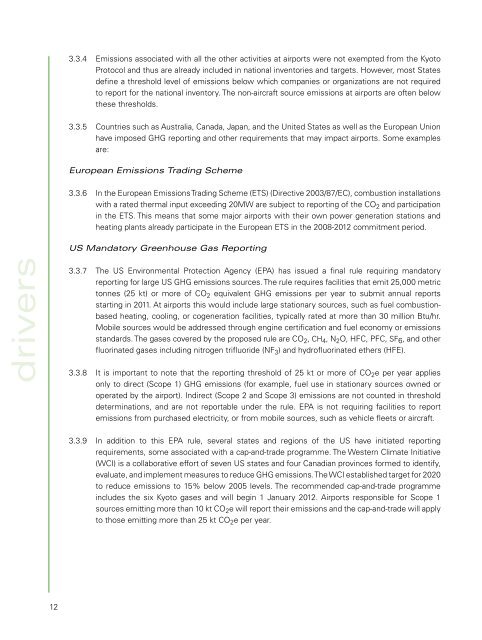Airport Greenhouse Gas Emissions Management - Zurich Airport
Airport Greenhouse Gas Emissions Management - Zurich Airport
Airport Greenhouse Gas Emissions Management - Zurich Airport
You also want an ePaper? Increase the reach of your titles
YUMPU automatically turns print PDFs into web optimized ePapers that Google loves.
3.3.4 <strong>Emissions</strong> associated with all the other activities at airports were not exempted from the Kyoto<br />
Protocol and thus are already included in national inventories and targets. However, most States<br />
define a threshold level of emissions below which companies or organizations are not required<br />
to report for the national inventory. The non-aircraft source emissions at airports are often below<br />
these thresholds.<br />
3.3.5 Countries such as Australia, Canada, Japan, and the United States as well as the European Union<br />
have imposed GHG reporting and other requirements that may impact airports. Some examples<br />
are:<br />
European <strong>Emissions</strong> Trading Scheme<br />
3.3.6 In the European <strong>Emissions</strong> Trading Scheme (ETS) (Directive 2003/87/EC), combustion installations<br />
with a rated thermal input exceeding 20MW are subject to reporting of the CO 2 and participation<br />
in the ETS. This means that some major airports with their own power generation stations and<br />
heating plants already participate in the European ETS in the 2008-2012 commitment period.<br />
US Mandatory <strong>Greenhouse</strong> <strong>Gas</strong> Reporting<br />
drivers<br />
3.3.7 The US Environmental Protection Agency (EPA) has issued a final rule requiring mandatory<br />
reporting for large US GHG emissions sources. The rule requires facilities that emit 25,000 metric<br />
tonnes (25 kt) or more of CO 2 equivalent GHG emissions per year to submit annual reports<br />
starting in 2011. At airports this would include large stationary sources, such as fuel combustionbased<br />
heating, cooling, or cogeneration facilities, typically rated at more than 30 million Btu/hr.<br />
Mobile sources would be addressed through engine certification and fuel economy or emissions<br />
standards. The gases covered by the proposed rule are CO 2 , CH 4 , N 2 O, HFC, PFC, SF 6 , and other<br />
fluorinated gases including nitrogen trifluoride (NF 3 ) and hydrofluorinated ethers (HFE).<br />
3.3.8 It is important to note that the reporting threshold of 25 kt or more of CO 2 e per year applies<br />
only to direct (Scope 1) GHG emissions (for example, fuel use in stationary sources owned or<br />
operated by the airport). Indirect (Scope 2 and Scope 3) emissions are not counted in threshold<br />
determinations, and are not reportable under the rule. EPA is not requiring facilities to report<br />
emissions from purchased electricity, or from mobile sources, such as vehicle fleets or aircraft.<br />
3.3.9 In addition to this EPA rule, several states and regions of the US have initiated reporting<br />
requirements, some associated with a cap-and-trade programme. The Western Climate Initiative<br />
(WCI) is a collaborative effort of seven US states and four Canadian provinces formed to identify,<br />
evaluate, and implement measures to reduce GHG emissions. The WCI established target for 2020<br />
to reduce emissions to 15% below 2005 levels. The recommended cap-and-trade programme<br />
includes the six Kyoto gases and will begin 1 January 2012. <strong>Airport</strong>s responsible for Scope 1<br />
sources emitting more than 10 kt CO 2 e will report their emissions and the cap-and-trade will apply<br />
to those emitting more than 25 kt CO 2 e per year.<br />
12

















